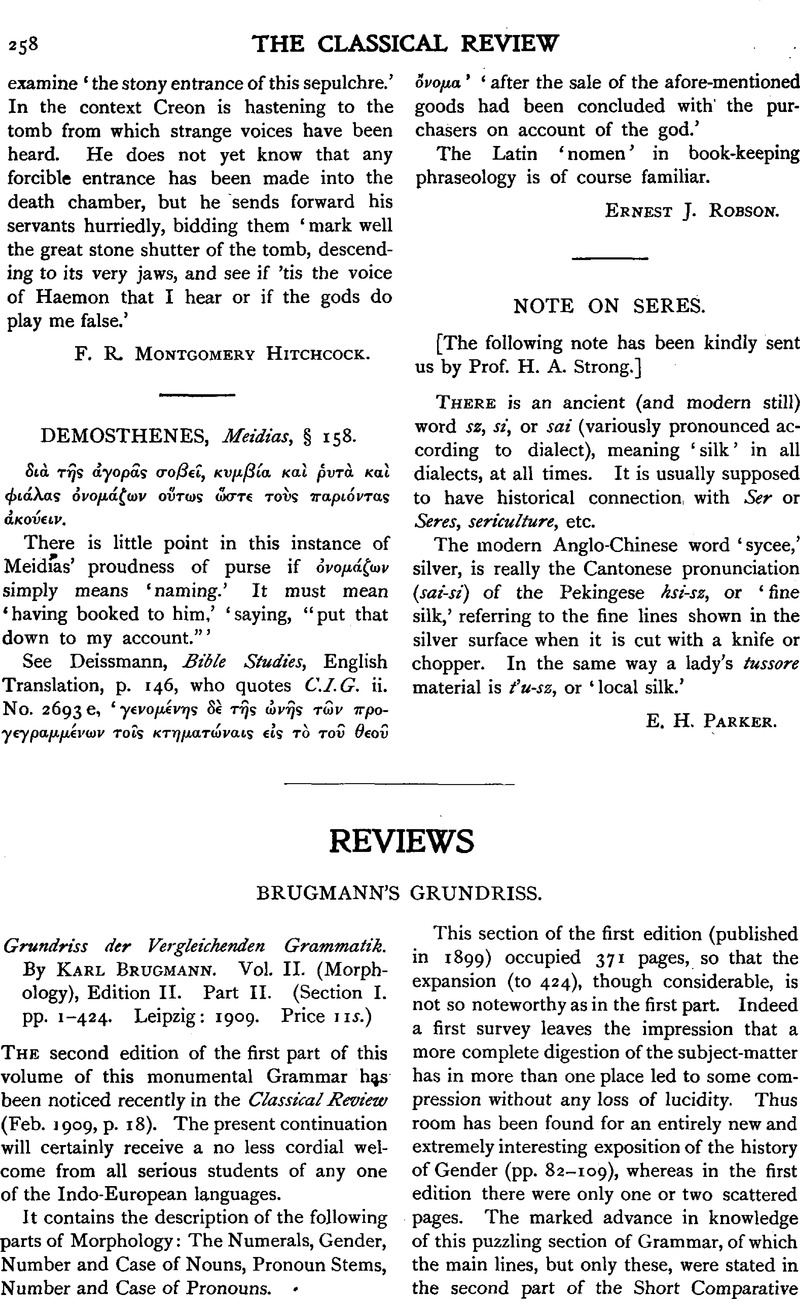No CrossRef data available.
Article contents
Brugmann's Grundriss - Grundriss der Vergleichenden Grammatik. by Karl Brugmann. Vol. II. (Morphology), Edition II. Part II. (Section I. pp. 1–424. Leipzig: 1909. Price 115.)
Published online by Cambridge University Press: 27 October 2009
Abstract

- Type
- Reviews
- Information
- Copyright
- Copyright © The Classical Association 1909
References
1 I must not repeat here the explanation of the process by which the -ā- and -i- suffixes took up the meaning of female sex as one of their functions, as readers of this Review will find it set out fully in Vol. XVIII. (1904), p. 413.
2 The only point I have noticed in which the rather disconcerting brevity of Brugmann's earliest writing seems to reappear is the treatment of the final -ī in Gr. ![]() and the like (p. 321 and p. 328). Here one would like some fuller discussion of the suggestion that this suffix is identical with the Feminine form of the Pronoun, but we are only referred to what is said very briefly on p. 361 of the Short Comparative Grammar, and the earlier discussion in Delbrück's part of the Grundriss (Vergleichende Syntax, Strassburg, 1893, p. 469). Is it quite fair to the purchaser of the second edition of the large Grundriss to refer to a shorter treatise which has appeared between the first and second editions? This is perhaps more to be regretted as the explanation there given (namely, that the forms in -ī in Indo-European still retained the collective non-sexual meaning which originally belonged to the suffix) appears to be brilliant and convincing. For instance, I.-Eu. *sī-si (from which sprang the originals of English she and German sie) meant to start with ‘thisness,’ ‘this group’; and other Pronouns with the same ending had an equally vague signification, soaring above and behind the petty distinctions of Gender and Number. Hence the schoolboy's enemy the Homeric μιν and the Attic νιν with their incorrigible uncertainty of meaning. This example of teaching by references is very unlike the method of the volume in general.
and the like (p. 321 and p. 328). Here one would like some fuller discussion of the suggestion that this suffix is identical with the Feminine form of the Pronoun, but we are only referred to what is said very briefly on p. 361 of the Short Comparative Grammar, and the earlier discussion in Delbrück's part of the Grundriss (Vergleichende Syntax, Strassburg, 1893, p. 469). Is it quite fair to the purchaser of the second edition of the large Grundriss to refer to a shorter treatise which has appeared between the first and second editions? This is perhaps more to be regretted as the explanation there given (namely, that the forms in -ī in Indo-European still retained the collective non-sexual meaning which originally belonged to the suffix) appears to be brilliant and convincing. For instance, I.-Eu. *sī-si (from which sprang the originals of English she and German sie) meant to start with ‘thisness,’ ‘this group’; and other Pronouns with the same ending had an equally vague signification, soaring above and behind the petty distinctions of Gender and Number. Hence the schoolboy's enemy the Homeric μιν and the Attic νιν with their incorrigible uncertainty of meaning. This example of teaching by references is very unlike the method of the volume in general.




